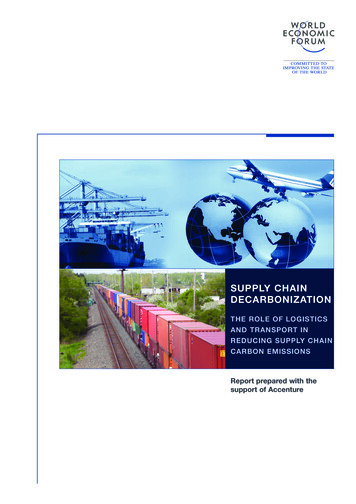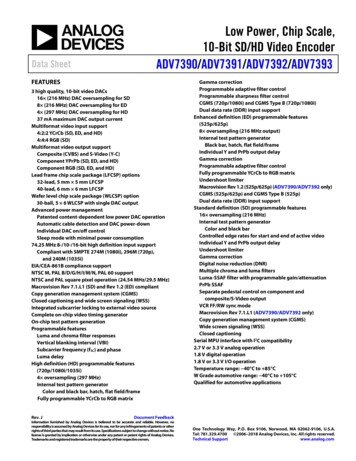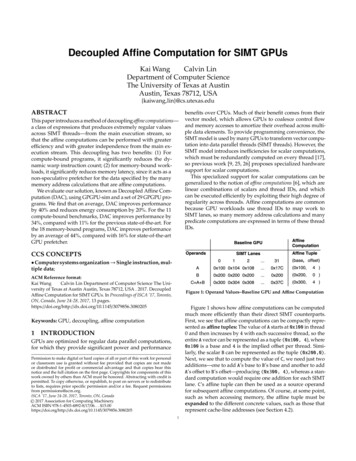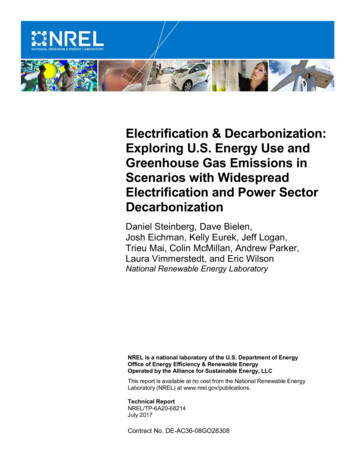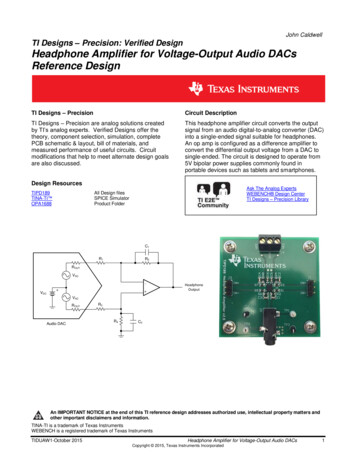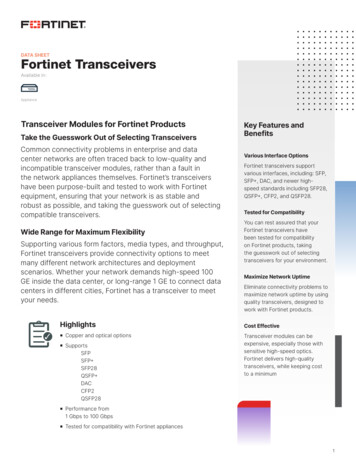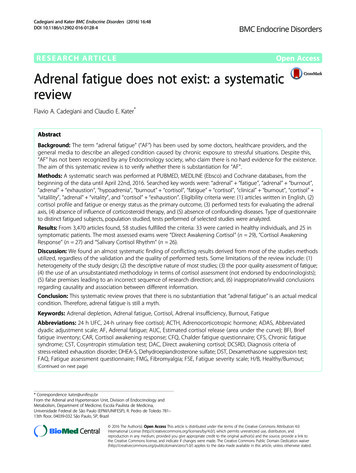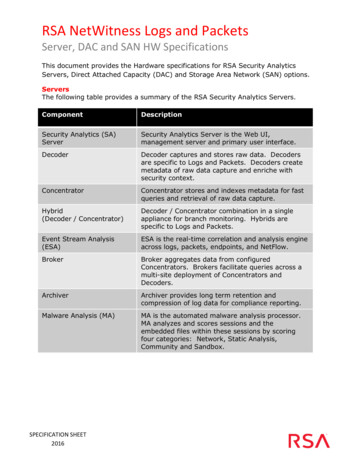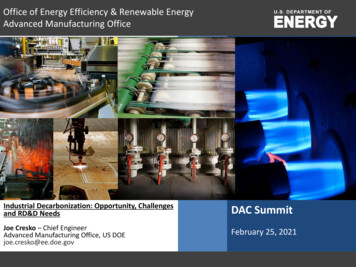
Transcription
Office of Energy Efficiency & Renewable EnergyAdvanced Manufacturing OfficeIndustrial Decarbonization: Opportunity, Challengesand RD&D NeedsDAC SummitJoe Cresko – Chief EngineerAdvanced Manufacturing Office, US DOEjoe.cresko@ee.doe.govFebruary 25, 2021Program Name or Ancillary Texteere.energy.gov
Opportunity Space for Manufacturing Improve the energy and carbon productivity of U.S. manufacturing.Reduce life cycle energy and resource impacts of manufactured goods.Manufacturing GoodsUse of Manufactured GoodsMore efficient manufacturing reducesenergy lossesand More efficient manufacturingenables technologies that improveenergy use throughout the economy:Data for 20141 Transportation Buildings Energy Production and DeliveryEnergy consumption by sector from EIA Monthly Energy Review, 20182 Industrial non-manufacturing includes agriculture, mining, and construction3 US economy energy losses determined from LLNLEnergy Flow Chart 2014 (Rejected Energy),adjusted for manufacturing losses4 Manufacturing energy losses determined from DOE AMO Footprint Diagrams (2014 data)U.S. Energy Economy by Sector98.5 quadrillion Btu, 2014 1
Industrial Sector is a Significant Contributor to CO₂ Emission The U.S. Industrial Sector accountsfor 32% of the nation’s primaryenergy use and 28% of CO₂emissions. Anticipated industrial sector energydemand growth of 30% by 2050 mayincrease CO₂ emissions by 15%. Challenges for abating CO₂ emissionfrom the industrial sector:ooooothe diversity of industrial processing steps andenergy inputs used in manufacturingthe scale of facilities and lengthy timeframe forcapital turnoverthe cost of development to validate newtechnology at industrially-relevant scalescomplex supply chainscapital availabilityEIA, Annual Energy Outlook 2020 with Projections to 2050.2018 U.S. GHG emissions and FY20 DOE RD&D FundingV. Sivaram, Energizing America 2020
Process Emissions are significantSources: DOE (2014), EPA (2018).Rebecca Dell (2019).
Do our current frameworks demonstrate a lack of vision?Technology static over decades.Future structure largely based oncurrent structure.Pessimistic or pragmatic?Future looks verydifferent.Optimistic ordelusional?Decoupling Energy andCarbon Productivity5
AMO’s Approach
Drivers to Reduce Energy & Emissions through the Product Life CycleEnergy Intensity e.g.: Process efficiency Process integration Waste heat recoveryNewProcessesCarbon Intensity, e.g.:NewMaterials Process efficiencyFeedstock substitutionBiomass-based fuelsRenewablesUse Intensity e.g.: Circular Economy Design for Re-X (recycling reuseand remanufacturing) Material efficiency andsubstitutionImprovedProducts byNextGenerationMaterialsandProcessses.7
AMO Industrial Decarbonization Roadmap - Background Direction by Congressional House and Senate to “developdecarbonization roadmaps to guide R&D at the DOE to phase outnet GHG emissions by 2050” and opportunity to increase U.S.competitiveness in the industrial sector. The roadmap is the multi - lab effort (NREL, Berkeley, Argonne,Oak Ridge) in consultation with key stakeholders involved in theU.S industrial sector.o Focus on five industries: cement, iron & steel, food, andchemicals, petroleum refiningo External workshops with industry held in spring 2020
Motivation by Congressional Direction and theOpportunity for Enhanced U.S. Competitiveness The congressional direction guided the methodology and industry engagement.oThe Department shall develop decarbonization roadmaps in key technology areas to guide research anddevelopment at the Department to achieve significant, economical greenhouse gas emission reductions by2050, including energy efficiency, process electrification, industrial electrification technologies, and carboncapture. Roadmaps should be developed in consultation with external stakeholders and relevant officeswithin the Department. The industrial decarbonization roadmap builds off AMO prior analysis work including2015 Energy Bandwidth and Carbon Emission studies. Roadmap solicited input from varied sources. It focuses industry’s interests to enhanceU.S. competitiveness through pursuing RD&D needs and opportunities.
Decarbonization Roadmap Main TakeawaysComposite plot of GHG emissions reduction scenarios for the three decarbonization pillars across the ironand steel, chemical manufacturing, food manufacturing, petroleum refining and cement sectors. (Near zeroGHG scenario; excluding feedstocks) Identify barriers, pathways, RD&D needs, and opportunities, and propose RD&D action plan for each industry. Identified RD &D needs and opportunities are centered around three main decarbonization pillars for the U.Sindustry: Energy efficiency Electrification and low carbon fuels Carbon capture, utilization and storage These pillars are explored by studying crosscutting and sector specific technologies, process, and practice for thefive industries.
Multiple Pillars of Decarbonization Must be Pursued in ParallelLandscape of major RD&D investment opportunities for industrial decarbonization between now and 2050.A host of technical opportunities across a range of Technology Readiness Levels (TRLs)o Lower TRLs: Investments early-stage low carbon technologies will be needed soon to ensure futuremarket viability.o Higher TRLs: Prompt investments are also essential to lower adoption hurdles and rapidly scalelater-stage technologies
AMO FY20 Multi-Topic FOA* Topic 3.1: Integrating Carbon Captureand Utilization into Industrial ProcessesObjective:Reduce the carbon intensity of manufacturing and lower the barriers to deploying carboncapture systems.Goal:Develop innovative solutions that will integrate carbon capture systems in industry;develop manufacturing processes for new technologies that are effective at capturingcarbon dioxide from dilute sources including direct air capture (DAC); and enable thecost-effective utilization of captured carbon dioxide in the industrial sector.Focus Areas: Manufacturing processes, including material scale up, for new technologies that areeffective at capturing carbon from industrial and dilute sources. System integration challenges associated with integrating carbon capture technologies inindustry. Scale-up and “numbering up” (i.e. replication; nth plant) challenges of emerging carboncapture technology to achieve enonomies-of-scale cost reductions. New technologies to enable the utilization of captured carbon as a feedstock in a specificindustrial processing step(s). The carbon captured could be from concentrated and diluteindustrial sources or from ambient air. CCUS in co-located processes are encouraged.* Funding Opportunity Announcement (FOA) Number: DE-FOA-0002252
Topic domestic-manufacturing-through-0Sorbent Development and Scale-up for Industrial and DA CaptureProject TitleIntensified Water-Lean Solvent CO2 Capture System for Cement Flue GasSorbents Tailored for Emission Abatement in Manufacturing (STEAM)Developing Low-Cost Mfg. Processes for an Ultra-High Capacity CarbonCapture MaterialIntegrating CO2 Capture into Manufacturing ProcessesProject TitleAn Innovative Process for Direct Utilization of CO2 in Solid SyntheticPozzolan ProductionPerformance-Advantaged Chemicals & Materials made fromLignocellulose and CO2Lead PIResearch TriangleInstitutePalo Alto ResearchCenter, Inc.Mosaic Materials, Inc.Lead PISolidia TechnologiesReSource Chemical Corp.Integrating CCUS into Chemical Pulp ProcessesDecarbonization of Hydrogen Production by Flameless OxidationNC State UniversityPraxair, Inc.Direct Air Capture and Utilization IntegrationProject TitleScalable Integration of CO2 Capture and Electrocatalytic Conversion toOrganic LiquidsModular Reactors for the Capture and Electro-conversion of CO2 inVarious Industrial Processes to Value-Added ChemicalsLead PINorthern IllinoisUniversityUniversity of Louisiana atLafayette
Highlighted Selections Mosaic Materials: Developing Low-CostManufacturing Processes for an Ultra-HighCapacity Carbon Capture Material. Northern Illinois University: ScalableIntegration of CO2 Capture and ElectrocatalyticConversion to Organic Liquids. Work is aimed at improving and scaling themanufacturing of MOFs for DAC. Improvementsinclude: reduced carbon intensity, increasedscale, and reduced cost while retainingperformance.Development of devices for DAC and CO2utilization using state of the art active materials.Devices will be integrated and scaled up to makeethanol from air.University of Louisiana at Lafayette: ModularReactors for the Capture and Electroconversion of CO2 in Various IndustrialProcesses to Value-Added Chemicals. Developing modular system that combines acapture unit capable of DAC, with CO2electrochemical conversion unit.
Thank You.For additional ring-officeANL - Sarang SupekarLBNL –William MorrowNREL – Alberta Carpenter, Tsisilile Igogo, Colin McMillanORNL –Sachin NimbalkarACEEE – Ed Rightor, Neal ElliottConsultants – Ali Hasanbeigi, Bruce HedmanAMO – Kate Peretti, Felicia Lucci, Joe Cresko
Energy IntensityTechnical Energy Savings Opportunities:Energy Intensity e.g.:Process efficiencyProcess integrationWaste heat recoveryCarbon Intensity, e.g.:Process efficiencyFeedstock substitutionBiomass-based fuelsRenewablesUse Intensity e.g.:Circular economy Design forRe-X (recycling,reuse and remanufacturing)Material efficiency andsubstitutionSource: DOE/AMO, Energy Bandwidth Studies (2015)Note: 1 quad 1000 TBtu16
Carbon IntensityDirect emissions with efficiencyimprovements only Energy Intensity e.g.:Process efficiencyProcess integrationWaste heat recoveryCarbon Intensity, e.g.:Process efficiencyFeedstock substitutionBiomass-based fuelsRenewables and with fuel switching andmaterial substitutionUse Intensity e.g.:Circular economy Design forRe-X (recycling,reuse and remanufacturing)Material efficiency andsubstitutionExample analysis based in part on bandwidth SOTA & PM potential, and EIAAnnual Energy Outlook (AEO) forecast as baseline.17
Use IntensityEnergy Intensity e.g.:Process efficiencyProcess integrationWaste heat recoveryCarbon Intensity, e.g.:Process efficiencyFeedstock substitutionBiomass-based fuelsRenewablesUse Intensity e.g.:Circular economyDesign for Re-X (recycling,reuse and remanufacturing)Material efficiency andsubstitution18
Stakeholder Input to the Roadmap Proactive pursuit of multiple decarbonization pillars concurrently (e.g. energyefficiency, electrification and low-carbon fuels, and CCUS) is needed by leveragecurrent resources and programs from public and private sectors Investments in early, low-carbon process TRL technologies will be needed soon toensure future market viability. Focus is needed not just on new technologies, but on their integration into processsystems and supply chains to reduce energy and GHGs. Pursue low capital investment approaches highlighted by stakeholders, that havemultiple benefits and spur early action to reduce GHGs (e.g. energy, materials, systemefficiency). The timing and alignment with expansion of a renewable energy grid system will becritical Workforce development is needed across industries and a spectrum of skill sets.
Three Decarbonization Pillars with Examples of Technologies for theChemical IndustryEnergy EfficiencyStrategic energymanagementEnergy, systems, andmaterials efficiency(e.g., recycling andwaste ,intermittent powerProcess heatportfolioElectrolyzerSmart manufacturing efficiencyCombined heat andpower, andwaste heat to powerLow-carbonprocesses andcatalyst innovationsSystems efficiencyacross multipleoperationsEnergy/thermalstorage andrecoveryInnovativeseparationsCCUSIntegration withprocess heatCO2 reuse viaslip streamsCO2bioconversion
Industrial Sector is a Significant Contributor to CO₂Emission The U.S. Industrial Sector accounts for 32% of the nation's primary energy use and 28% of CO₂ emissions. Anticipated industrial sector energy demand growth of 30% by 2050 may increase CO₂emissions by 15%. Challenges for abating CO₂ emission from the industrial .
